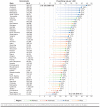Trends in Gabapentin Prescribing in a Commercially Insured U.S. Adult Population, 2009-2016
- PMID: 32105169
- PMCID: PMC7155217
- DOI: 10.18553/jmcp.2020.26.3.246
Trends in Gabapentin Prescribing in a Commercially Insured U.S. Adult Population, 2009-2016
Abstract
Background: Gabapentin is prescribed for a variety of conditions and is often used off label. It is important to understand the prevalence of gabapentin prescribing and the characteristics of individuals who are prescribed gabapentin, given increasing concern regarding its potential for misuse.
Objectives: To (a) examine state- and region-level prevalence and trends in gabapentin prescribing from 2009 to 2016 and (b) characterize demographic and clinical characteristics of individuals prescribed gabapentin in a nationwide population of commercially insured adults.
Methods: This retrospective, longitudinal study examined trends in gabapentin prescribing from 2009 to 2016. The study population included individuals aged 18-64 years who were enrolled in a commercial insurance plan at any point from 2009 to 2016. Individuals who were prescribed gabapentin were defined as beneficiaries with at least 1 gabapentin prescription claim in a calendar year (CY). A cross-sectional descriptive analysis was performed to examine differences in demographic and clinical characteristics of individuals prescribed or not prescribed gabapentin in CY 2016.
Results: The prevalence of gabapentin prescribing nearly doubled from 2009 to 2016. During this time, gabapentin prescribing increased in every state (range: 44%-179%). State-specific prevalence rates in 2016 varied from 12.7 to 43.9 per 1,000 beneficiaries. Overall, 2.7% of beneficiaries filled ≥ 1 gabapentin prescription in 2016. Individuals prescribed gabapentin were more likely to fill opioid prescriptions (60.8% vs. 16.5%, P < 0.01); reside in the South (53.7% vs. 47%, P < 0.01); be female (62.5% vs. 52.3%, P < 0.01); and be aged 55-64 years (41.7% vs. 21.2%, P < 0.01) compared with the comparator. Individuals who were prescribed gabapentin also had significantly higher rates of seizure disorders, neuropathic pain, mental health disorders, substance use disorders, and diabetes.
Conclusions: The prevalence of gabapentin prescribing among a U.S. privately insured population has increased steadily in recent years. Additional research should examine coprescribing of gabapentin in the context of the opioid epidemic.
Disclosures: The project described in this study was supported by the NIH National Center for Advancing Translational Sciences through grant number UL1TR001998. This study was also partially supported by grant number 2017-PM-BX-K026 (Data-Driven Responses to Prescription Drug Misuse in Kentucky) awarded by the Bureau of Justice Assistance. Viewpoints or opinions in this document are those of the authors and do not necessarily represent the official position or policies of the U.S. Department of Justice or the official views of the NIH. The authors do not have any conflicts of interest to report. Portions of this study have been previously presented in poster presentations at the 2019 Academy Health Annual Research Meeting; June 2-4, 2019; Washington, DC, and the 2019 University of Kentucky Substance Use Research Day; March 3, 2019; Lexington, KY.
Conflict of interest statement
The project described in this study was supported by the NIH National Center for Advancing Translational Sciences through grant number UL1TR001998. This study was also partially supported by grant number 2017-PM-BX-K026 (Data-Driven Responses to Prescription Drug Misuse in Kentucky) awarded by the Bureau of Justice Assistance. Viewpoints or opinions in this document are those of the authors and do not necessarily represent the official position or policies of the U.S. Department of Justice or the official views of the NIH. The authors do not have any conflicts of interest to report.
Portions of this study have been previously presented in poster presentations at the 2019 Academy Health Annual Research Meeting; June 2-4, 2019; Washington, DC, and the 2019 University of Kentucky Substance Use Research Day; March 3, 2019; Lexington, KY.
Figures
References
-
- Neurontin (gabapentin) capsules, for oral use. Parke-Davis, division of Pfizer. Revised October 2017. Available at: https://www.accessdata.fda.gov/drugsatfda_docs/label/2017/020235s064_020.... Accessed January 27, 2020.
-
- IQVIA Institute for Human Data Science. Medicine use and spending in the U.S.: a review of 2017 and outlook to 2022. April 19, 2018. Available at: https://www.iqvia.com/institute/reports/medicine-use-and-spending-in-the.... Accessed January 27, 2020.
-
- Serpell MG. Gabapentin in neuropathic pain syndromes: a randomised, double-blind, placebo-controlled trial. Pain. 2002;99(3):557-66. - PubMed
-
- Moore A, Derry S, Wiffen P. Gabapentin for chronic neuropathic pain. JAMA. 2018;319(8):818-19. - PubMed
MeSH terms
Substances
Grants and funding
LinkOut - more resources
Full Text Sources


